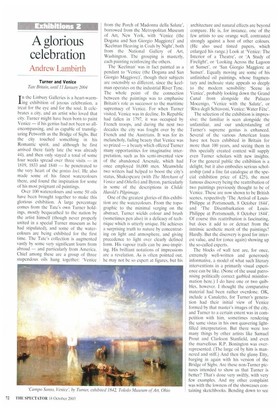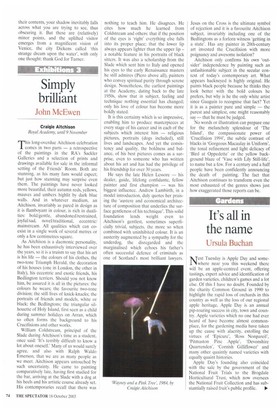A glorious celebration
Andrew Lambirth
Turner and Venice
Tate Britain. until 11 faIlilaly 2004
Tn the Linbury Galleries is a heart-warmling exhibition of joyous celebration, a treat for the eye and for the soul. It celebrates a city, and an artist who loved that city. Turner might have been born to paint Venice — if his genius had not been so allencompassing, and as capable of transfiguring Petworth as the Bridge of Sighs. But the city touched something in his Romantic spirit, and although he first arrived there fairly late (he was already 44), and then only stayed a total of some four weeks spread over three visits — in 1819, 1833 and 1840 — he penetrated to the very heart of the genius loci. He also made some of his finest watercolours there, and found the inspiration for some of his most poignant oil paintings.
Over 100 watercolours and some 50 oils have been brought together to make this glorious exhibition. A large percentage comes from the Tate's own Turner holdings, mostly bequeathed to the nation by the artist himself (though never properly united in a special Turner museum as he had stipulated), and some of the watercolours are being exhibited for the first time. The Tate's collection is augmented vastly by some very significant loans from abroad — and particularly from America. Chief among these are a group of three stupendous oils hung together: 'Venice from the Porch of Madonna della Salute', borrowed from the Metropolitan Museum of Art, New York, with 'Venice (the Dogana and San Giorgio Maggiore)' and `Keelman Heaving in Coals by Night', both from the National Gallery of Art. Washington. The grouping is masterly, each painting reinforcing the others.
The 'Keelman' was in fact painted as a pendant to 'Venice (the Dogana and San Giorgio Maggiore)', though their subjects are ostensibly so different, since the keelman operates on the industrial River Tyne. The whole point of the connection between the paintings was to emphasise Britain's role as successor to the maritime supremacy of Venice. For when Turner visited, Venice was in decline. Its Republic had fallen in 1797, it was occupied by French troops, and during the next two decades the city was fought over by the French and the Austrians. It was for its melancholy, fading beauty that Venice was so prized — a beauty which offered Turner many opportunities for imaginative interpretation, such as his semi-invented view of the abandoned Arsenale, which had once employed 16,000 men. Meanwhile two writers had helped to boost the city's status, Shakespeare (with The Merchant of Venice and Othello) and Byron, particularly in some of the descriptions in Childe Harold's Pilgrimage.
One of the greatest glories of this exhibition are the watercolours. From the topographic to the minimal verging on the abstract, Turner wields colour and brush (sometimes pen also) in a delicacy of technique which is utterly unique. He achieves a surprising truth to nature by concentrating on light and atmosphere, and giving precedence to light over clearly defined form. His vapour trails can be awe-inspiring. His brilliant notations of impressions are a revelation. As is often pointed out, he may not be so expert at figures, but his architecture and natural effects are beyond compare. He is, for instance, one of the few artists to use orange well, contrasted strongly against a host of other colours. (He also used tinted papers, which enlarged his range.) Look at 'Venice: The Interior of a Theatre', or 'A Study of Firelight', or 'Looking Across the Lagoon at Sunset', or 'San Giorgio Maggiore at Sunset'. Equally moving are some of his unfinished oil paintings, whose fragmentary and inchoate state appeals so deeply to the modern sensibility: 'Scene in Venice', probably looking down the Grand Canal from alongside the Palazzo Mocenigo, 'Venice with the Salute', or `Riva degli Schiavoni, Venice: Water Fête'.
The selection of the exhibition is impressive: the familiar is seen alongside the unfamiliar, and our understanding of Turner's supreme genius is enhanced. Several of the various American loans have not been exhibited in Britain for more than 100 years, and seeing them in this specially created context will supply even Turner scholars with new insights. For the general public the exhibition is a delight, but it also embodies serious scholarship (and a fine fat catalogue at the special exhibition price of f25), the most famous discovery being the reattribution of two paintings previously thought to be of Venice. These are now shown to be British scenes, respectively 'The Arrival of LouisPhilippe at Portsmouth, 8 October 1844', and 'The Disembarkation of LouisPhilippe at Portsmouth, 8 October 1844'. Of course this reattribution is fascinating, but does it add to or detract from the intrinsic aesthetic merit of the paintings? Hardly. But the discovery is good for interest value, and for (once again) showing up the so-called experts.
The blocks of wall text are, for once, extremely well-written and generously informative, a model of what such literary interventions in a primarily visual experience can be like. (None of the usual patronising politically correct garbled misinformation here.) I do have one or two quibbles, however. I thought the comparative material had been rather overdone. OK, include a Canaletto, for Turner's generation had their initial view of Venice formed by that master's images of the city, and Turner to a certain extent was in competition with him, sometimes rendering the same vistas in his own quavering lightfilled interpretation. But there were too many things by other artists like Samuel Prout and Clarkson Stanfield, and even the marvellous R.P. Bonington was overrepresented. (The large oil by him is mannered and stiff.) And then the glassy Etty, barging in again with his version of the Bridge of Sighs. Are these non-Turner pictures intended to show us that Turner is better? That's done very swiftly, with very few examples. And my other complaint was with the lowness of the showcases containing sketchbooks. Bending down to see their contents, your shadow inevitably falls across what you are trying to see, thus obscuring it. But these are (relatively) minor points, and the uplifted visitor emerges from a magnificent vision of Venice, the city Dickens called 'this strange dream upon the water', with only one thought: thank God for Turner.



































































































 Previous page
Previous page